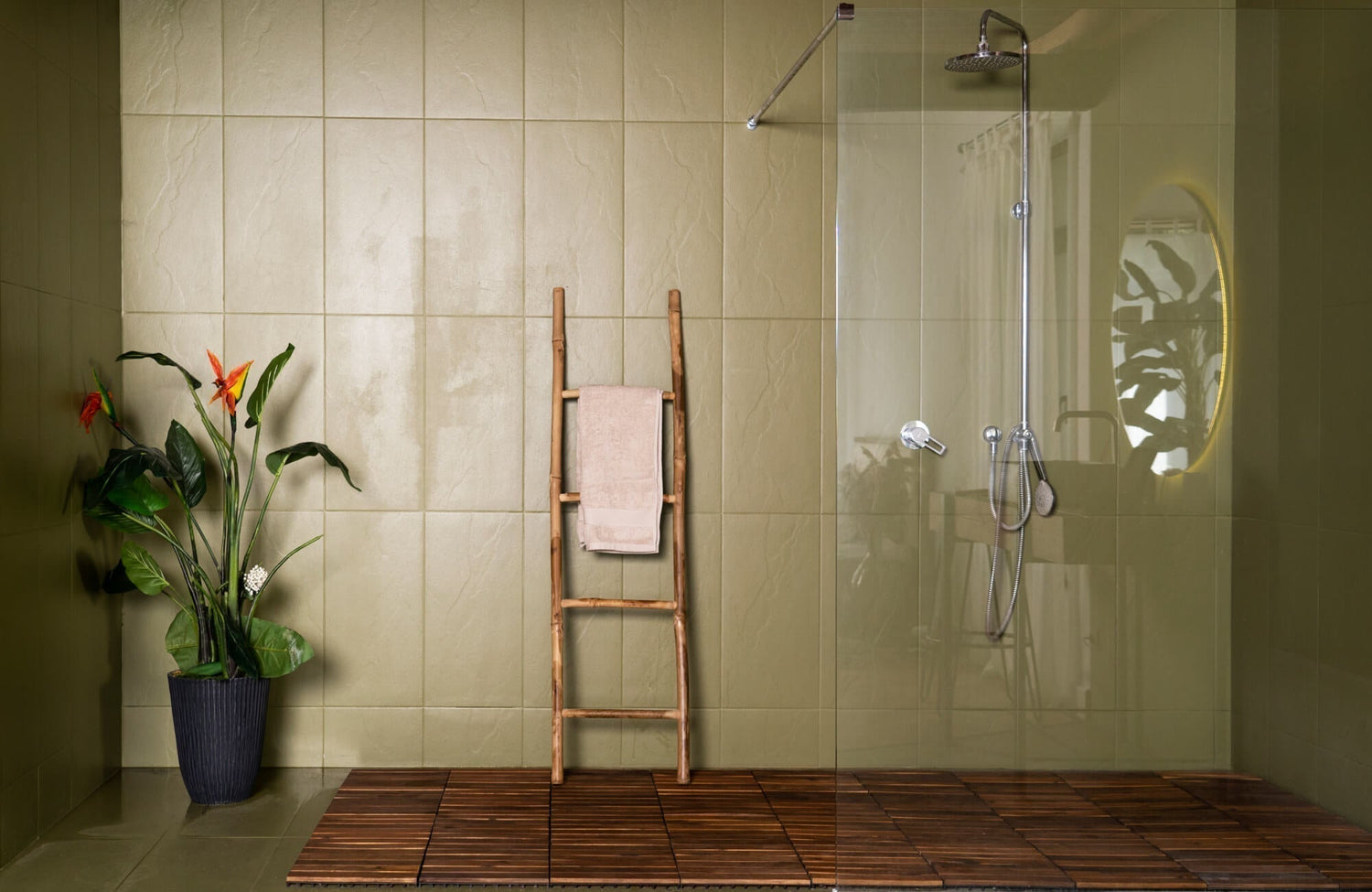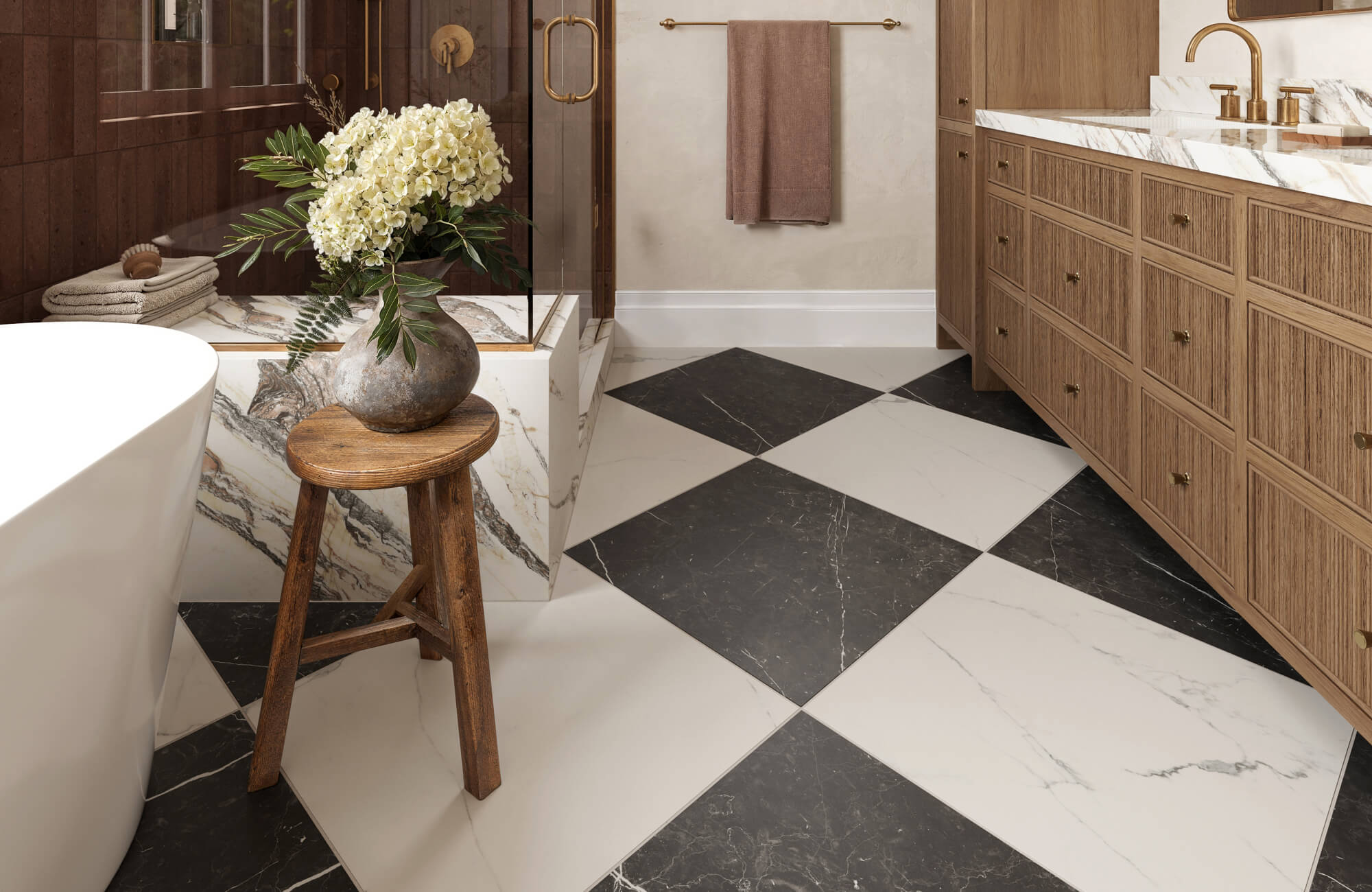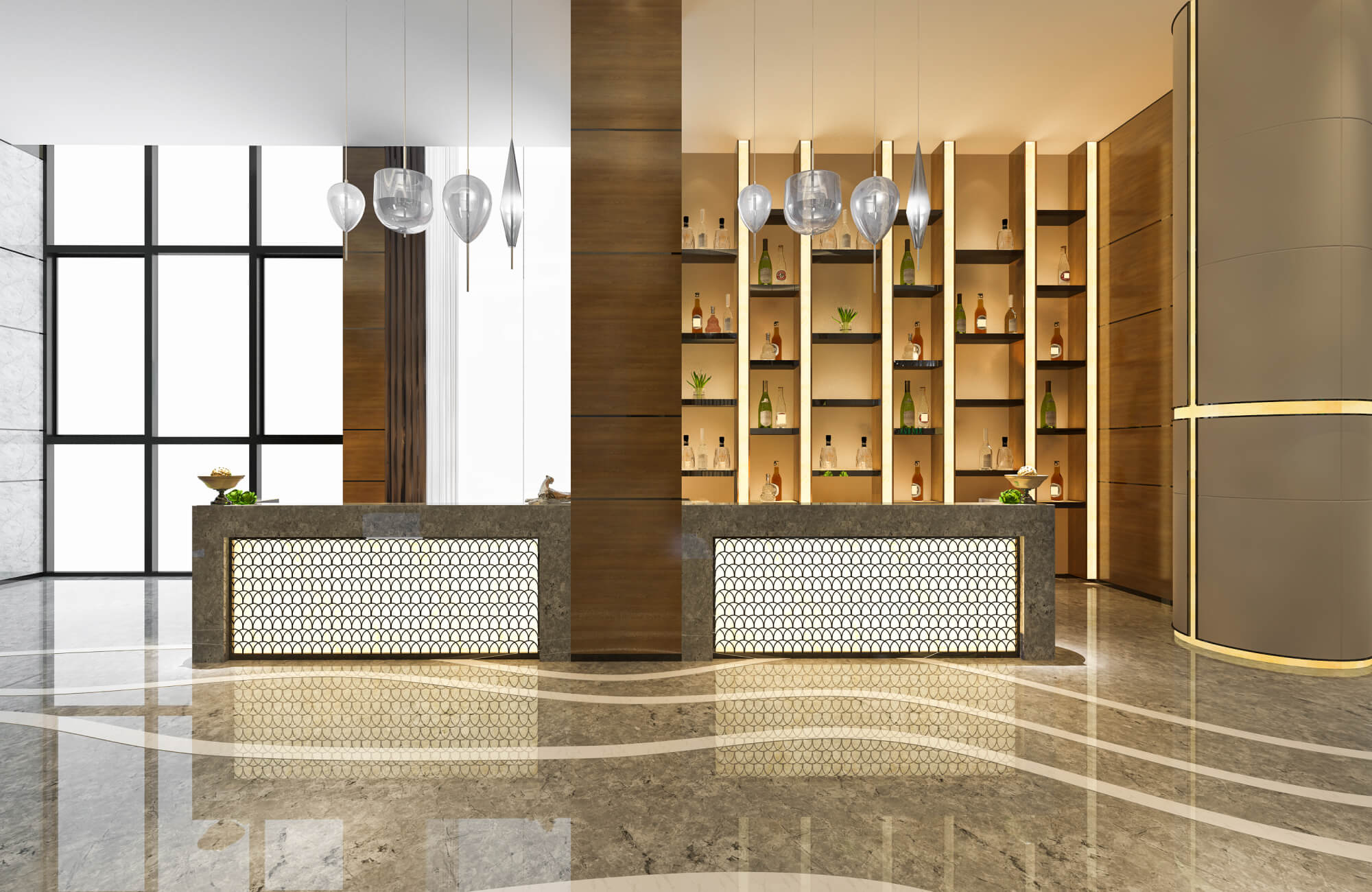When selecting shower tiles, it's essential to choose materials that can withstand constant moisture and daily use. However, not all tiles are suited for wet environments—some absorb too much water, become dangerously slippery, or deteriorate over time, leading to safety hazards and high maintenance.
This article explores the types of tiles to avoid, highlighting those prone to water absorption, slipperiness, and structural weakness. By understanding these risks, you can make informed decisions and select tiles that promote a safe, durable, and low-maintenance shower. Additionally, we’ll highlight the best tile options for bathrooms, focusing on moisture-resistant, slip-resistant, and long-lasting materials that enhance both functionality and style.

Tiles That Absorb Too Much Water
Certain tiles lack the water resistance needed for constant moisture exposure, making them prone to mold, structural issues, and early deterioration. In showers, frequent water contact increases the risk of absorption, gradually weakening the tiles. Excess moisture can also lead to cracks, discoloration, and potential damage to the underlying structure, making shower tile selection a crucial consideration.
Porous Natural Stone and Its Weaknesses
Natural stone lends a sophisticated, high-end appeal to showers, but not all types are suited for wet environments. Limestone and travertine, for instance, have a naturally porous structure that readily absorbs water. Without adequate protection, prolonged moisture exposure leads to internal deterioration, weakening the shower tile’s structure over time. While frequent sealing helps create a temporary moisture barrier, it does not eliminate the risk entirely. Even with regular maintenance, these stones remain susceptible to water penetration, making them a high-maintenance choice for shower spaces.
Beyond structural concerns, excessive moisture fosters mold growth and mineral buildup, further affecting both aesthetics and hygiene. One common issue is efflorescence, a white residue that forms when dissolved minerals in water migrate to the tile’s surface. If not cleaned regularly, these deposits harden, making removal difficult and diminishing the stone’s visual appeal. The repeated cycle of moisture exposure also causes expansion and contraction, which can lead to cracks or even detachment from walls and floors. Over time, this compromises the stability of the installation, leading to costly repairs. Given these ongoing challenges, highly porous natural stones are an impractical choice for shower environments.
Why Unglazed Ceramic Tiles Are a Bad Choice
Unglazed ceramic tiles lack a protective coating, making them highly susceptible to water infiltration. Unlike glazed ceramic tiles, which have a vitrified surface that repels moisture, unglazed varieties absorb water quickly, leading to warping, staining, and structural weakening. Prolonged exposure to moisture can also cause hairline fractures, gradually compromising the integrity of the shower enclosure.
These tiles are also especially prone to mold growth, particularly in grout lines where moisture tends to linger. Even mild exposure to soapy water and shampoo residue can cause discoloration over time, further diminishing their appearance. Like other absorbent materials, unglazed ceramic also expands and contracts with moisture fluctuations, increasing the risk of cracks and detachment. Without proper sealing and waterproofing, these tiles deteriorate quickly in wet environments, making them unsuitable for long-term use in showers.

Slippery Tiles That Increase Fall Risks
A shower floor should provide enough traction to prevent slipping, but some tiles become dangerously slick when wet, increasing the risk of falls. The combination of smooth surfaces, water, and soap residue can make certain materials unsafe underfoot. To ensure a secure and stable surface, it’s crucial to choose tiles with adequate slip resistance.
The Importance of Slip-Resistance Ratings
Slip resistance is measured using the coefficient of friction (COF) or the dynamic coefficient of friction (DCOF), which indicates how much force is needed to cause slippage. For wet areas like showers, tiles with a DCOF of 0.42 or higher are recommended to provide sufficient traction.
Many high-gloss tiles, including certain ceramic and porcelain options, do not meet this standard and can also become dangerously slippery when wet. To enhance safety, it’s important to check slip resistance ratings and choose tiles with textured, honed, or matte finishes for better grip.
Large Format Tiles Without Proper Traction
Oversized tiles provide a seamless aesthetic with minimal grout lines, but in showers, they reduce traction. Grout lines create ridges that improve grip, but large tiles have fewer joints, resulting in a smoother, more slippery surface.
Additionally, large shower tiles require precise leveling during installation. Any imperfections in the slope can cause water to pool rather than drain efficiently, increasing the risk of slipping. Without textured finishes, large format tiles make showers unsafe, particularly for children and older individuals.
Polished Marble and Other Glossy Stones
Polished natural stones like marble and granite offer a refined appearance, but their glossy finish poses a slipping hazard in wet conditions. The smooth surface also lacks the friction necessary to prevent falls. While some homeowners choose marble for its elegance, it requires anti-slip coatings or textured finishes to improve safety.
Even when sealed, polished stone surfaces remain vulnerable to water pooling. Over time, exposure to moisture and cleaning agents can degrade the polish, making the surface even more unpredictable. The maintenance required to sustain both safety and appearance also makes these materials a risky choice.

High-Maintenance Tiles That Are Difficult to Clean
Some shower tiles require frequent upkeep to stay in good condition, adding extra effort to regular cleaning routines. While appearance is also important, practicality should be a key consideration when selecting shower tiles to ensure long-term ease of maintenance.
Textured Tiles That Trap Dirt and Grime
Highly textured shower tiles, such as rough-cut stone or deeply grooved surfaces, present cleaning challenges. While textured surfaces improve slip resistance, they also trap dirt, soap scum, and mildew. The deeper the grooves, the harder it becomes to remove debris, requiring frequent scrubbing.
Shower tiles with natural cleftings, such as slate, demand meticulous maintenance to prevent buildup in uneven areas. Without regular sealing and deep cleaning, textured surfaces become breeding grounds for mold.
Soft Materials That Stain Easily
Certain soft materials, such as terracotta and unsealed cement shower tiles, absorb water and develop stains. Terracotta tiles have a high porosity that makes them vulnerable to discoloration from hard water deposits, shampoos, and cleaning agents. Similarly, cement tiles require sealing to prevent staining and degradation.
Even with sealants, these materials also demand ongoing maintenance, as protective coatings wear down with regular cleaning. The need for frequent resealing and specialized care makes soft, stain-prone tiles less practical.
Light-Colored Grout Lines
Grout helps secure shower tiles in place, but light-colored grout in wet environments can be difficult to maintain. White or beige grout lines, in particular, easily stain from soap residue, mildew, and mineral deposits, requiring frequent cleaning to prevent discoloration.
Unsealed grout is even more susceptible to moisture absorption, which can also lead to premature deterioration and mold growth. To reduce upkeep, epoxy-based grout is a better choice, as it resists water absorption and stains more effectively than traditional cement-based grout.

Tiles That Are Prone to Cracking or Breaking
Durability is essential in a shower, where tiles must withstand heat, humidity, and constant exposure to moisture. Some materials are too fragile for these conditions, making them prone to cracking or failing over time. Fluctuations in temperature and moisture levels cause expansion and contraction, which weaker tiles cannot endure. Additionally, sudden impacts, like a dropped bottle, can lead to surface fractures, further compromising their integrity.
Thin Glass Tiles That Shatter Under Pressure
Glass tiles are popular for their reflective qualities, but they are not always practical for showers. While smaller glass mosaics hold up well due to added grout support, larger glass tiles are more prone to stress fractures. Thin glass, in particular, can crack under pressure or impact, making it a less durable choice for high-moisture areas.
Another drawback is their tendency to highlight imperfections. Trapped moisture, uneven adhesive application, or slight structural shifts can become visible through the translucent surface. Over time, continuous exposure to moisture can weaken the adhesive backing, causing tiles to loosen or detach.
Improperly Installed Tiles That Crack Under Stress
Even durable shower tiles can crack if not installed correctly, as weak points form from poor subfloor preparation, inadequate mortar coverage, or missing expansion joints. Over time, constant exposure to heat, humidity, and moisture causes expansion and contraction, adding stress to improperly secured tiles.
If the substrate is uneven or lacks proper support, tiles may shift with temperature changes, eventually leading to cracks or detachment. Without a stable foundation and quality adhesives, moisture can seep beneath the surface, further compromising tile integrity. Ensuring a well-prepared base, proper adhesion, and adequate spacing allows tiles to accommodate movement, reducing the risk of premature failure.
Why Some Low-Quality Tiles Fail Over Time
Budget-friendly tiles may seem like a cost-effective choice, but they often lack the durability needed for long-term shower use. Lower-grade ceramics, for example, are made from coarser clay and fired at lower temperatures, resulting in a weaker structure. These shower tiles are more prone to cracking under pressure and struggle to withstand prolonged moisture exposure.
Inconsistent glazing quality can also lead to premature wear. A thin or unevenly applied glaze may chip away, exposing the porous interior to water infiltration. Once moisture seeps in, the tile begins to weaken, deteriorating faster and requiring replacement sooner than expected.

Incompatible Tiles for High-Humidity Environments
Shower tiles must endure constant exposure to steam and moisture, but not all materials can handle high humidity. Some are prone to expansion, weakened adhesives, and accelerated mold growth, leading to long-term damage that affects both appearance and functionality. To ensure a durable installation, it’s important to choose tiles specifically designed to resist these moisture-related issues.
Wood Tiles That Warp and Expand
Wood tiles are not suitable for wet environments like showers due to their high moisture absorption. When exposed to water, natural wood swells, warps, and eventually rots, compromising both appearance and structural integrity. Even engineered wood, which is designed to be more moisture-resistant, cannot withstand the constant humidity and direct water exposure found in a shower.
As wood absorbs moisture, it expands and contracts, leading to gaps, misalignment, and instability over time. This movement weakens the tile’s bond to the substrate, increasing the likelihood of detachment. No matter how well-sealed, wood tiles are also inherently vulnerable to water damage, making them an impractical choice for shower installations.
Metal Tiles That Develop Corrosion and Rust
Metal tiles or metal-accented designs add a sleek, industrial look but are not ideal for showers due to their susceptibility to corrosion. While stainless steel and aluminum offer some resistance, prolonged exposure to steam and standing water leads to oxidation, rust, and surface degradation.
Protective coatings can delay rusting, but over time, moisture exposure wears them down, leaving the metal vulnerable. Additionally, metal tiles conduct heat more than other materials, making surfaces uncomfortably hot in a steamy shower. The maintenance required to prevent tarnishing and rust buildup makes metal tiles impractical for wet areas.
Why Some Adhesive-Backed Tiles Fail in Showers
Peel-and-stick tiles or adhesive-backed options may work for temporary installations but are not designed for shower conditions. These tiles rely on pressure-sensitive adhesives that weaken when exposed to heat and humidity. As moisture penetrates the adhesive, tiles start to peel, creating gaps where water can seep behind and cause damage.
Many peel-and-stick shower tiles also have limited resistance to direct water contact. Over time, water infiltration breaks down the backing, causing tiles to lose their bond to the wall. The lack of a waterproof seal makes these tiles a poor choice for showers.

Outdated or Nonfunctional Tile Choices
Some tile trends may not be suitable for showers, either because they lack functionality in wet conditions or because their aesthetics become outdated over time. As design preferences evolve, certain styles may no longer align with modern shower requirements, leading to higher maintenance demands or outdated appearance.
Tiny Mosaic Wall Tiles That Lead to Grout Overload
Mosaic tiles can add beautiful detail to shower walls, but using very small tiles creates an excessive number of grout lines. While grout helps secure tiles and adds texture, it is also porous unless properly sealed. The more grout joints there are, the greater the risk of moisture absorption, making mosaic wall tiles more prone to mold and mildew buildup over time.
Keeping mosaic wall tiles clean can also be challenging due to the narrow spaces between each piece. Grout in wet environments is more likely to discolor, often requiring frequent scrubbing or resealing to maintain a fresh look. While small-scale mosaics work well as accents, covering entire shower walls with them increases upkeep, making them a less practical choice for a low-maintenance design.
Overly Trendy Designs That Lack Long-Term Appeal
Bold tile patterns and unconventional colors may feel trendy at first, but design trends change quickly. Highly specific styles, such as bright geometric patterns or unusual textures, can become outdated over time, often requiring remodeling sooner than anticipated.
While aesthetics are important, functionality should be the priority in a shower. Tiles with intricate ornamentation or unconventional shapes can create installation challenges, leading to misalignment and irregular grout spacing. Opting for timeless materials with subtle texture or pattern variations not only enhances visual appeal but also simplifies installation, ensuring a shower remains both stylish and practical for years to come.
Tiles That Don’t Align with Modern Shower Designs
Modern shower designs prioritize functionality, easy maintenance, and long-lasting performance, but some tiles fail to meet these essential requirements. Glossy finishes, intricate embossed patterns, and unconventional materials often struggle with prolonged moisture exposure, making upkeep increasingly challenging. Over time, these choices can become more of a burden, requiring frequent maintenance and repairs.
By selecting materials specifically engineered for wet environments, you can ensure a shower that remains stylish, low-maintenance, and durable for years to come.

Best Shower Tiles for Safety and Durability
Selecting the right shower tiles is about more than just aesthetics. It is essential to prioritize safety, water resistance, and long-term durability. In moisture-prone areas, tiles should offer a secure, slip-resistant surface while maintaining their strength and integrity over time.
For shower walls, ceramic tiles are a practical choice due to their water-resistant and low-maintenance properties. The best example is the Mikayla 5x5 Glossy Ceramic Tile in Olive, featured above. It offers a smooth, easy-to-clean surface that prevents moisture penetration, reducing the risk of mold and mildew. Its durable composition also ensures long-lasting performance in wet conditions.
For shower floors, porcelain tiles offer exceptional durability and slip resistance. Edward Martin’s Ramsey 2x2 Matte Porcelain Mosaic Tile in Khaki features a textured matte finish and small grout joints that improve traction, helping to reduce the risk of slipping in wet conditions. Its mosaic format also enhances water drainage, making it both a practical and stylish choice. Similarly, the Levi 12x12 Matte Porcelain 1x1 Hexagon Mosaic Tile in Black provides excellent grip and durability, ensuring a secure and long-lasting shower floor.
As a non-porous material, porcelain mosaic tiles resist water absorption, preventing moisture buildup and mold growth while enhancing long-term durability. These mosaic tiles also come in sheet formats, allowing for easier installation and seamless integration into shower designs.
By choosing moisture-resistant ceramic tiles for walls and slip-resistant porcelain tiles for floors, you can create a shower that is both safe and built to last.
Choosing the Right Shower Tiles
The wrong shower tiles can lead to safety hazards, frequent maintenance, and long-term damage. Materials that absorb too much water, become slippery when wet, or weaken in humid conditions should be avoided. Instead, opting for moisture-resistant, slip-resistant, and durable tiles ensures a shower that is both functional and visually appealing while reducing upkeep and repair costs. Beyond aesthetics, durability also plays a key role in preventing moisture damage, mold growth, and structural issues over time.
To help you visualize your ideal shower design, try our Augmented Reality (AR) tool and see how different tile options will look in your space before making a decision. If you need expert guidance, our team is here to help. Contact us for personalized recommendations and find the perfect shower tiles for your home!







